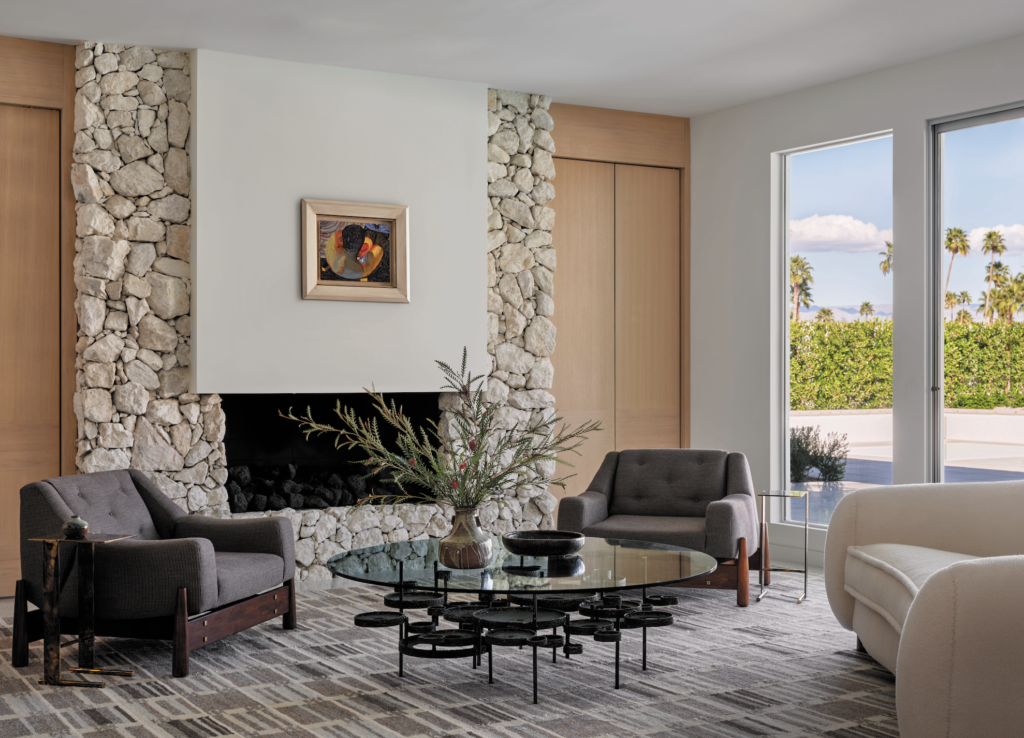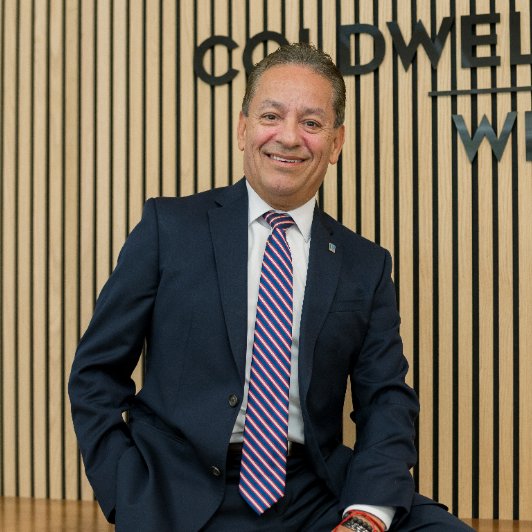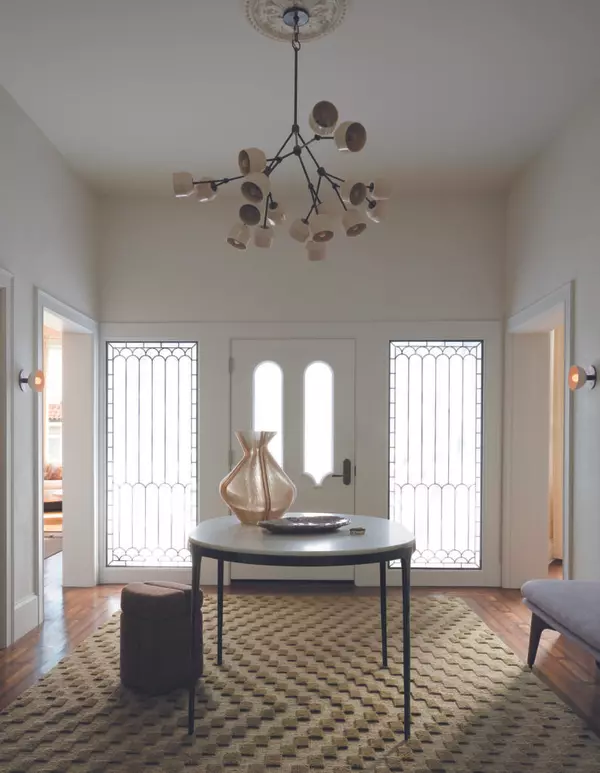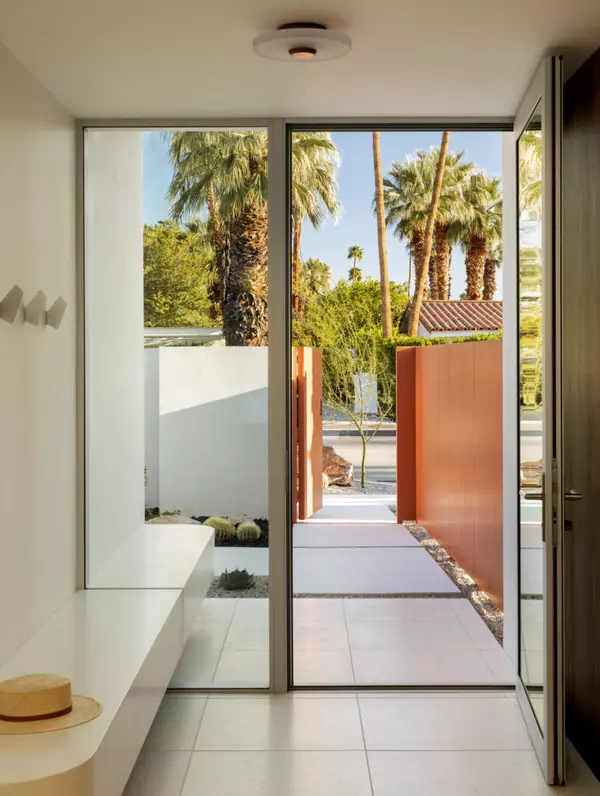Peace at Last
A mid-century modern home in Palm Springs finally gets a beautiful, peaceful interior that makes the most of its elegant bones

The yellow door house had long been a fixture on the Palm Springs’ Modernism Week home-tour circuit. Built in 1964 for Avery Rennick, a furniture designer and one of the original developers of the Sunset Strip, and his wife, Virginia, it had spent the last decade as an Airbnb. Catering to out-of-town visitors enraptured by a Palm Springs aesthetic born of movies and television shows, its highlighter-hued door opened onto an interior that was a hodgepodge of technicolor furniture, wildly patterned rugs, bold art, bright accessories and colorful walls.


Photos by Read McKendree.
But after its sale to an East Coast-based couple with a sophisticated sensibility and multiple properties, and under the direction of Todd Raymond of Studio Todd Raymond, the sunshine-tinged front door disappeared. Newly washed in Farrow & Ball’s Broccoli Brown, a color the paint company describes as “reserved and comforting in equal measure,” it hinted at the significant transformation that the home had undergone.


The new owners hadn’t provided Studio Todd Raymond with much of a design brief. “They told us to do what we do,” Raymond remembers. His work, which relies on layering, texture and the intriguing juxtaposition of shape and style to create interiors that are modern, timeless and welcoming, stands in sharp contrast to the bright, shiny, mid-century soul that lies at the heart of Palm Springs. They’re also decidedly monochromatic. “People often joke that our studio doesn’t do much color,” Raymond admits. “I mean, we do use color but in a natural, more organic way.”

Raymond wanted to avoid mid-century modern stereotypes, understanding that the city’s reliance on its past can straight jacket an interior designer’s creativity. “Sometimes Palm Springs can skew a little cliché, and we definitely wanted to get away from that,” he shares. He undertook a tip-to-toe renovation of the house that brought it in line with today’s standards while retaining its most outstanding features. “Our goal was to remain true to its spirit while stretching the definition to create something that felt contemporary and more global in scope.”
To do that, he strengthened the home’s strong architectural lines and highlighted the iconic Empress breeze blocks that enclosed the front patio. He worked with a landscape designer to highlight the home’s compelling angularity by contrasting it with the wild, flailing branches of an two massive olive trees and a spare, desert- inspired landscape. Inside, he blew out the side walls of the living room’s imposing dolomite fireplace, opening up the room to the den.

Now millwork portal doors flank the brawny stonework, showcasing its virile beauty. He had the worn terrazzo floors redone, giving the home a fresh clean platform on which to showcase a selection of voluptuous and tactile furnishings. “We kept the big broad strokes of what mid-century is but brought the home into the 21st century.”

Raymond applied that same ethos to choosing the home’s furniture and accessories. “We wanted to incorporate the overall essence of that time period but open it up to what was going on in other parts of the world,” he explains. “We blended the fun, geometric shapes of that period, abstractly pulling them out and using them throughout the house in different ways.” Witness the oblong oval-punctuated geometry of the floating credenza that welcomes visitors into the front hallway, the concentric circles that make up the base of the living room’s coffee table, the pedestal table that dominates the kitchen’s eating area or the Brazilian lounge chairs in the living room that jump-started the entire project. “They have a weight and a slouchiness to them that we used throughout the interior,” Raymond explains. Raymond’s propensity for neutrals buoyed the project’s objectives. “The clients collect art so we wanted to create spaces where it would stand out and where we had the flexibility to rotate pieces in and out,” he says. “So the palette was a little more muted, a little more dusty, and we played with texture rather than color.”


He also had fun with shape and weight. Despite the subdued hues of the pieces he chose, their heft helps balance the impact of the arresting art. And, importantly, their generous proportions telegraph comfort and ease. “The clients love to entertain, whether that’s dinner parties or having people over for drinks,” Raymond clarifies. “So we chose furniture that felt warm and inviting, where people would
feel relaxed having a martini and hanging out, chitchatting for two or three hours.” To confirm that laid-back vibe, the team relied on performance fabrics; their easy-care qualities help ensure this home is lock-and-leave simple.

“They had us do everything, from the construction to the cutlery,” Raymond says. “We don’t always get to do that, but we love it when we do. It helps us tell a complete story.” Here, that’s a tale of rest and rejuvenation, beauty and ease. Happily ever after accomplished!
The post Peace at Last appeared first on California Home+Design.
GET MORE INFORMATION












